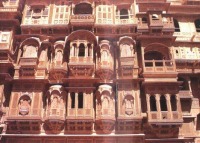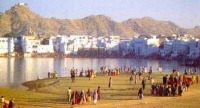Rajasthan is a land where the vagaries of nature have settled to co-exist with the good cheer of its people. The architectural grandeur of royalty and the tales of valour and chivalry are the essence of its very spirit. Rajasthan is a destination that enchants the visitor with every little discovery that is made, because the more one discovers, the more is the urge to stay on or come back. It offers a unique destination for anyone’s holidays.
Jaipur, the first planned city of historic India, better known as the pink city and the Venice of east is a perfect combination of old and modern architect of India. Pushkar is your host for rural, religion and culture of the region. The Thar Desert tells a story of men living in harmony with a hostile nature. It is not deserted but contains a complete philosophy to live with the nature. Ranthambore presents an opportunity for viewing wild life as you can experience the first hand the habitat of the king of the forest the tiger. The following ‘tour’ is in two parts but shows how you can easily explore parts of Rajasthan.
JAIPUR
 Jaipur, popularly known as the Pink City, was
founded in 1727 AD by the Maharaja of Amber Sawai Jai Singh.
This remarkable city is considered a marvel of town planning.
Designed in accordance with ancient Hindu treaties on
architecture, the Silpa Shastra, Jaipur follows a grid system
and is encircled by a fortified wall. The palace lies
in the heart of the city and occupies the space of the
central grid. The rest of the grids were cut across neatly by
wide lanes, which divided the area into tidy, well laid-out
rectangles of commercial and residential use. The fortified
wall has eight gates (originally had seven) and was built for
protection against invading armies and wild animals. Today
the city has spread beyond these walls and reached
neighbouring towns and continues to grow.
Jaipur, popularly known as the Pink City, was
founded in 1727 AD by the Maharaja of Amber Sawai Jai Singh.
This remarkable city is considered a marvel of town planning.
Designed in accordance with ancient Hindu treaties on
architecture, the Silpa Shastra, Jaipur follows a grid system
and is encircled by a fortified wall. The palace lies
in the heart of the city and occupies the space of the
central grid. The rest of the grids were cut across neatly by
wide lanes, which divided the area into tidy, well laid-out
rectangles of commercial and residential use. The fortified
wall has eight gates (originally had seven) and was built for
protection against invading armies and wild animals. Today
the city has spread beyond these walls and reached
neighbouring towns and continues to grow.
CITY PALACE
The city Palace complex is the most important landmark with its numerous outbuildings, courtyards, impressive gateways and temples. Occupying one seventh of the walled city area, the city palace houses the seven storied Chandra Mahal (residence of the royal family), Mubarak Mahal, the Diwan-I-Am, and Diwan-I-Khas. The museum houses a rare collection of arms, carpets, costumes, paintings and royal paraphernalia. A notable exhibit is a pair of pure silver containers, which are the largest single pieces of silver in the world.
Across the road from the palace is the JANTAR MANTAR, one of the five observatories built by Sawai Jai Singh, this one is the latest and the best preserved. A collection of complex astronomical instruments chiselled out of stone – most of which continue to provide fairly accurate information to this day – is the highlight of the observatory.
HAWA MAHAL (PALACE OF WINDS)
This adjoins the outside of the palace wall. Built in 1799 this pink seven storied building overlooks one of the main streets and also provides some excellent views of the city. Dedicated to the lord Krishna, it is shaped like a crown, which adorns the Lord’s head. It has over 900 niches and is quite an unusual structure the likes of which are not to be found anywhere else in the world.
AMBER FORT
Set in a picturesque location, Amber is a fascinating blend of Hindu and Muslim architecture. Built in the 16th century by Raja Man Singh, it sprawls on the hillside. Built in red sandstone and white marble, the palace complex has some very interesting apartments, the likes of which are not to be found anywhere else in the country. Jai Mandir, Sheesh Mahal, Sukh Niwas, Ganesh Pol are some of the prominent areas of interest. The old township of Amber lies at the foothills of the palace and has an Old World charm, a character of its own.
PUSHKAR FAIR (November)
 Held at Pushkar near Ajmer once in a year,
better known by the name of Pushkar Cattle Fair, is one of
the most colourful festivals of India. Thousands of pilgrims
come to bathe in the holy water of the Pushkar Lake. Legend
has it that the lake appeared miraculously on the spot, where
the petals of the lotus fell from the hands of lord Brahma.
Pushkar has an atmosphere of an ancient town, peaceful and
secluded but for twelve days of the month of KARTIK (Hindu
calendar), it transformed into a spectacular fair ground.
The fair is an amazing sight to behold including street
sellers showing off their dazzling range of wares in hundreds
of roadside stalls.
Held at Pushkar near Ajmer once in a year,
better known by the name of Pushkar Cattle Fair, is one of
the most colourful festivals of India. Thousands of pilgrims
come to bathe in the holy water of the Pushkar Lake. Legend
has it that the lake appeared miraculously on the spot, where
the petals of the lotus fell from the hands of lord Brahma.
Pushkar has an atmosphere of an ancient town, peaceful and
secluded but for twelve days of the month of KARTIK (Hindu
calendar), it transformed into a spectacular fair ground.
The fair is an amazing sight to behold including street
sellers showing off their dazzling range of wares in hundreds
of roadside stalls.
RELIGIOUS ACTIVITIES
 People come from different parts of
Rajasthan to worship lord Brahma and take bath in the holy
lake. Pilgrims start coming in the early morning in
groups singing the religious songs dedicated to Hindu gods to
bathe in the Pushkar lake. The process continues throughout
the day to turn into DEEPDAN ceremony. The entire
atmosphere reverberates with the ringing of bells. At
night, hundreds of small oil lamps placed on green leaves set
the lake alight. Shopkeepers keeps their shops open day
and night for the last three or four days to keep the city
alive.
People come from different parts of
Rajasthan to worship lord Brahma and take bath in the holy
lake. Pilgrims start coming in the early morning in
groups singing the religious songs dedicated to Hindu gods to
bathe in the Pushkar lake. The process continues throughout
the day to turn into DEEPDAN ceremony. The entire
atmosphere reverberates with the ringing of bells. At
night, hundreds of small oil lamps placed on green leaves set
the lake alight. Shopkeepers keeps their shops open day
and night for the last three or four days to keep the city
alive.
CAMELS AND CATTLE
Worlds largest number of camel gathering is a spectacular seen that floods this area with thousands of tourist every year. The most spectacular site besides the animals is the day to day activity of the people who comes with the animals and spend the day and night under open sky. Horse races, camel races and other animal based events are organized by the organizing committee to choose the best animal of the fair.
If you would like to get in touch with Bhaghirath about touring Rajasthan, he can be contacted by e-mail on: vision21century@sify.com
Discuss this article and give feedback in our online forum
